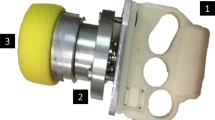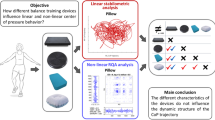Abstract
In this study a description of balance response to sudden external perturbations of the upright posture was performed. To this aim, subjects underwent to a series of translational perturbations at fixed speed in backward and forward direction. Center of pressure (CoP) displacement was analyzed in terms of temporal and spatial characteristics, showing a repeatable waveform which allowed the identification of two main response periods: the destabilizing and the counterbalancing phase. Different control features of balance response have been observed in both phases, with a temporal-based control of CoP displacement in the first phase and an amplitude-based control in the second one. Moreover, the analysis of CoP could be useful to identify the presence of the first trial effect and the habituation rate, two well-known features of perturbed posturography. These findings could contribute to the understanding of balance control in perturbed conditions and suggest CoP as a valuable measure in studying not only the quiet but also the perturbed stance.
Preview
Unable to display preview. Download preview PDF.
Similar content being viewed by others
References
1. Prieto TE, Myklebust JB, Hoffmann RG et al. (1996) Measures of Postural Steadiness: Differences Between Healthy Young and Elderly Adults. IEEE Trans Biomed Eng 43(9):956–966 DOI 10.1109/10.532130
2. Nardone A, Galante M, Pareyson D et al. (2007) Balance control in Sensory Neuron Disease. Clin Neurophysiol 118(3):538–550 DOI 10.1016/j.clinph.2006.11.012
3. Sinha T, Maki BE (1996) Effect of Forward Lean on Postural Ankle Dynamics. IEEE Trans Rehabil Eng 4(4):348–359
4. Tsai YC, Hsieh LF, Yang S (2014) Age-related changes in posture response under a continuous and unexpected perturbation. J Biomech 47(2):482–490 DOI 10.1016/j.jbiomech.2013.10.047
5. Maranesi E, Merlo A, Fioretti S et al. (2016) A statistical approach to discriminate between non-fallers, rare fallers and frequent fallers in older adults based on posturographic data. Clin Biomech 32:8–13 DOI 10.1016/j.clinbiomech.2015.12.009
6. Nonnekes J, Scotti A, Oude Nijhuis LB et al. (2013) Are postural responses to backward and forward perturbations processed by different neural circuits?. Neuroscience 245:109–120 DOI 10.1016/j.neuroscience.2013.04.036
7. Visser JE, Carpenter MG, van der Kooij H et al. (2008) The clinical utility of posturography. Clin Neurophysiol 119(11):2424–2436 DOI 10.1016/j.clinph.2008.07.220
8. Oude Nijhuis LB, Allum JH, Borm GF et al. (2009) Directional Sensitivity of “First Trial” Reactions in Human Balance Control. J Neurophysiol 101(6):2802–2814 DOI 10.1152/jn.90945.2008
9. Quant S, Maki BE, McIlroy WE (2005) The association between later cortical potentials and later phases of postural reactions evoked by perturbations to upright stance. Neurosci Lett 381(3):269–274 DOI 10.1016/j.neulet.2005.02.015
10. Maranesi E, Fioretti S, Ghetti GG et al. (2016) The surface electromyographic evaluation of the Functional Reach in elderly subjects. J Electromyogr Kinesiol 26:102–110 DOI 10.1016/j.jelekin.2015.12.002
11. Hansen PD, Woollacott MH, Debu B (1988) Postural responses to changing task conditions. Exp Brain Res 73(3):627–636
12. Leardini A, Sawacha Z, Paolini G et al. (2007) A new anatomically based protocol for gait analysis in children. Gait Posture 26(4):560–571 DOI 10.1016/j.gaitpost.2006.12.018
13. Winter DA, Patla AE, Prince F et al. (1998) Stiffness control of balance in quiet standing. J Neurophysiol 80(3):1211–1221
14. de Lima-Pardini AC, Papegaaij S, Cohen RG et al. (2012) The interaction of postural and voluntary strategies for stability in Parkinson’s disease. J Neurophysiol 108(5): 1244–1252 DOI 10.1152/jn.00118.2012
15. Nanhoe-Mahabier W, Allum JH, Overeem S et al. (2012) First trial reactions and habituation rates over successive balance perturbations in Parkinson’s disease. Neuroscience 217:123–129 DOI 10.1016/j.neuroscience.2012.03.064
16. Bloem BR, van Vugt JP, Beckley DJ et al. (1998) Habituation of lower leg stretch responses in Parkinson’s disease. Electroencephalogr Clin Neurophysiol 109(1):73–77
Author information
Authors and Affiliations
Corresponding author
Editor information
Editors and Affiliations
Rights and permissions
Copyright information
© 2018 Springer Nature Singapore Pte Ltd.
About this paper
Cite this paper
Mengarelli, A., Cardarelli, S., Fioretti, S., Burattini, L., Di Nardo, F., Verdini, F. (2018). Center of Pressure based Assessment of Balance Responses to Repeated Perturbations of Upright Stance. In: Eskola, H., Väisänen, O., Viik, J., Hyttinen, J. (eds) EMBEC & NBC 2017. EMBEC NBC 2017 2017. IFMBE Proceedings, vol 65. Springer, Singapore. https://doi.org/10.1007/978-981-10-5122-7_66
Download citation
DOI: https://doi.org/10.1007/978-981-10-5122-7_66
Published:
Publisher Name: Springer, Singapore
Print ISBN: 978-981-10-5121-0
Online ISBN: 978-981-10-5122-7
eBook Packages: EngineeringEngineering (R0)




